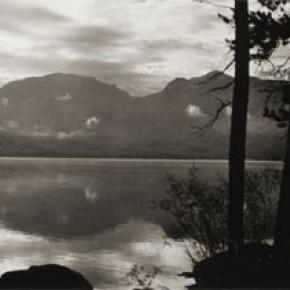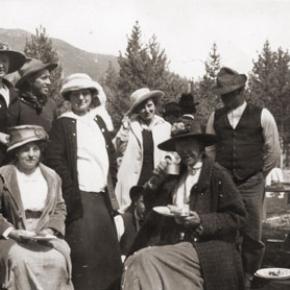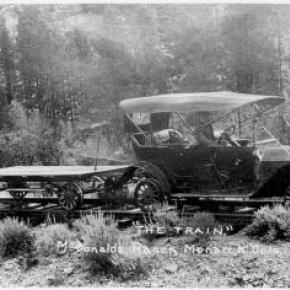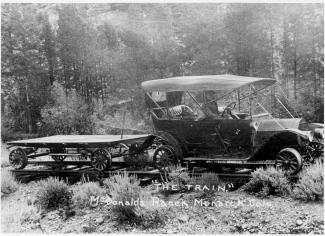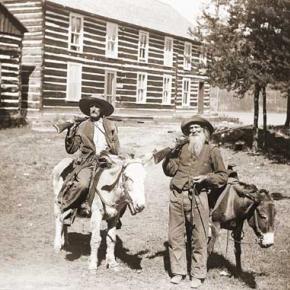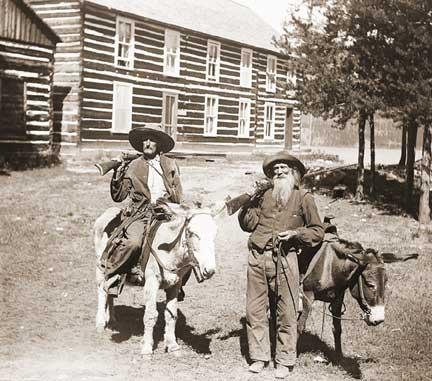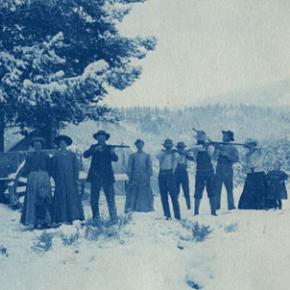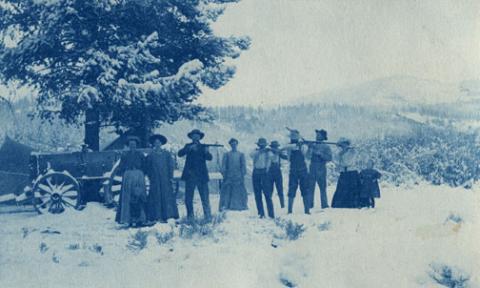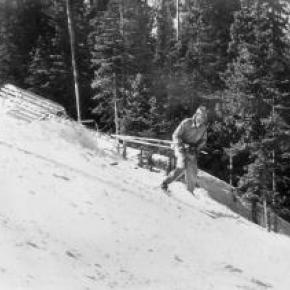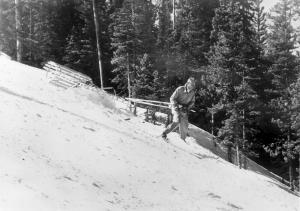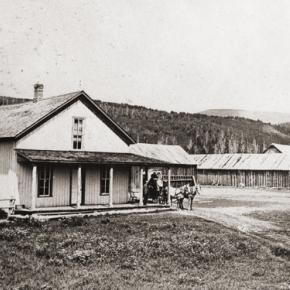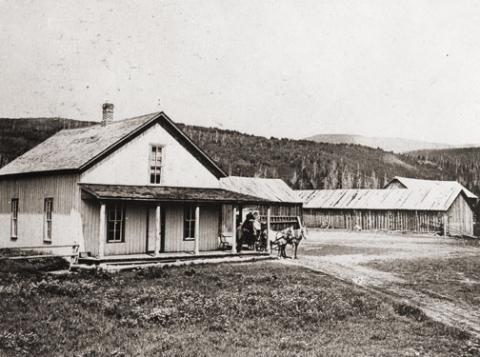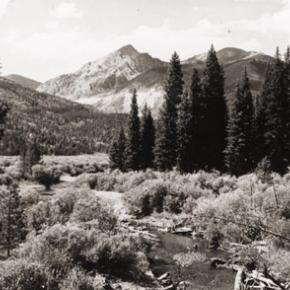Community Life Articles
| Fraser Valley Library |
Fraser Valley Library
The Fraser Valley Library primarily serves the southeast area of The first recorded library in the Fraser area was a cupboard full of books in the old Fraser Mercantile during the 1950s. Later the library moved across the railroad tracks to share the tiny town hall. In the mid-1970s, the Miller family acquired a former John Deere building from |
| Good Eye Bill and the Deadly Feud |
Good Eye Bill and the Deadly Feud
Article Contributed by Fran Cassidy The Depression of the 1930's had its effect all over the In the afternoon of The three visitors left and headed for the nearby forest and Good Eye asked The loggers returned to the cabin and noticed that Good Eye had a bloody arm. He described what had happened and pointed to the body. Penna suggested they take Good Eye to town and advise the Sheriff. An area sheep rancher, William Foley, was passing by with his flock and saw Sources: The Inquest reports
|
| Granby Rampage |
Granby Rampage

On June 4th, 2004 an armored D-9 Caterpillar was used by disgruntled Granby businessman Marv Heemeyer in a rampage that caused an estimated $5 million in damage and left part of the town of Granby in rubble. Heemeyer's slow-moving, 90 minute demolition, fueled by his anger at local officials and business owners who supported construction of a cement batch plant, left 13 buildings demolished or damaged and ended when he committed suicide inside the cab that he had welded shut. The buildings targeted included the town hall, the library, the electric company, a bank, the newspaper and the home of the former mayor. The town of Granby was spared any human injuries or loss because of the complete evacuation of the town through the reverse 911 system and many local law enforcement officers who went door to door to warn the townspeople. The town of Granby immediately launched fundraising efforts to offset the losses suffered by targeted businesses and citizens and the destroyed buildings were mostly rebuilt by the following year. |
| Granby Then and Now |
Granby Then and Now
Contributed by Vera "Stathos" Shay, Kremmling I've just read " What a great history My little town, of way long ago A tiny bit of that time Was a part of mine With me forever Forget you never I've kept up I've kept in tact This little girl that Lived across the track That railroader's little brat I'm proud and happy to say Was my home, in my childhood day.
|
| Grand County Libraries |
Grand County Libraries

In 1938, At about the same time, the federated women's clubs in In 1994, the Committee to Protect the Library was established to petition the Board of Commissioners to increase funding for the library to set aside a completely separate library fund, which would be administered as a Library District. The voters approved the move on Today, the library still serves that same basic function for the community as well as new roles acquired in the intervening years. |
| Grand Lake Yacht Club |
Grand Lake Yacht Club

Grand County often attracts adventurous spirits who prefer its splendid isolation to Wal-Mart and fast food. Others, who never make the leap of faith to live here, enjoy it as a familiar playground, returning regularly to enjoy its vast mountain ranges and unlimited outdoor opportunities. It has to come many as a surprise to learn that Grand Lake, Colorado - nestled next the Continental Divide at over 8,300 feet elevation - has had a yacht club for over one hundred years! When this adventure began, back in 1902, there was only a stage road into the southeast corner of Grand County over Berthoud Pass. Grand Lake is situated next to the entrance of Rocky Mountain National Park, at the far northeast corner of the county, with the rugged backbone of the continent directly to the north and east. At the turn of the twentieth century, it was a summer vacation spot with few full-time residents. Summer visitors and full-time residents alike recognized the grandeur of the their surroundings, and Grand Lake very early became a summer home to many of Denver's elite, and the summer business they brought helped support the local economy. It was a few enthusiastic Denverites with a keen interest in Grand Lake and sailing who organized the Grand Lake Yacht Club over 100 years ago. The founders included Richard Crawford Campbell, who married Senator Thomas Patterson's daughter and became the business manager of his father's newspaper, the Rocky Mountain News; William Henry Bryant, a Denver lawyer who was active in both sailing and Colorado politics; J. Fermor Spencer, a close friend of Mr. Bryant and long-time treasurer of the club; and William Bayard Craig, who enjoyed a broad education and had been the Chancellor of Duke University before he became interested in "acquiring land in Colorado." By the end of 1902, according to Denver papers, "the first bona fide yacht club between the Mississippi river and the Pacific ocean" was in operation. An atmosphere of excitement and pageantry swept over Grand Lake during the early Regatta weeks, when the Yacht Club held its annual races. In Denver, The Friday Evening Times proclaimed during August of 1904, "Yachting season is here", and went on to describe the "enthusiastic cottagers gathered on shore" around Grand Lake to cheer for the yachts. In 1907, Regatta week included yacht racing as well as foot races, donkey races and bronco busting. When the yacht races ended, the boat captain who won the most races had earned the Colorado Cup. The Grand Lake Yacht Club's small sailing fleet during Regatta week - three days of racing during mid-August - sometimes included only a handful of boats during its first decade or so. Still, according to one observer, "the organization has more spirit to the square foot than I ever saw exhibited before." Races on the first day of Regatta week, 1905, illustrate the enthusiasm well. In the hotly contested first race of Regatta week, Robert Campbell's Highball, built in Racine, Wisconsin, tossed her two-man crew into the icy waters of Grand Lake when she capsized while running in second place. Shortly after, the third place yacht, Duchess, went over too, leaving the Chicago-built Dorothy II captained by Commodore Bryant the first and only boat to cross the home buoy. Today, Dorothy O'Donnell O'Ryan, Commodore Bryant's granddaughter, maintains her family's summer home in Grand Lake. In 2002, she published Sailing Above the Clouds: An Early History of the Grand Lake Yacht Club, which chronicles the club's first 50 years. Her Colorado roots go back to Colorado territory's last, and the state of Colorado's first Governor, John Long Routt, who was appointed by President Grant in 1875, the year before Colorado became a state. Knowing the early history as she does, and the difficulties inherit with mountain transportation, O'Ryan marvels at "the logistics" of bringing sailboats built in Racine, Wisconsin or Chicago, Illinois over the Continental Divide into Grand County, Colorado by rail and stage road. Home-built crafts, both crude and highly crafted, competed as well. Many of the first home-built boats were modified rowboats, "with homemade sails and masts." Observing the annual Regatta week in August of 1904, though, Arthur Johnson called attention to "the Jessica, a 16-foot boat belonging to the vice-commodore and built at Grand Lake" that sported "a sail that would have done credit to a venturesome Lipton on the high seas." If a sailboat in Grand Lake during 1904 "done credit to a venturesome Lipton," Sir Thomas Lipton himself returned the favor tenfold in 1912. It so happened in 1912 that Lipton was traveling by train across the United States and would pass through Denver on his journey. Probably, Sir Thomas had met the well-traveled and enthusiastic yachtsman, William H. Bryant (Grand Lake Yacht Club Commodore) at the New York Yacht Club. Continued correspondence between the two resulted in the Grand Lake Yacht Club inviting Sir Thomas to the Denver Club for dinner in December of 1912, sponsored, of course, by the Grand Lake Yacht Club. Before he left that evening, flattered by the warm welcome he received, Lipton had proffered a silver cup to the Grand Lake Yacht Club. Lipton became a yachting icon during the early 20th century. His sportsmanship was nearly unparalleled in the sport and he spent most of 30 years and millions of dollars trying to win the America's Cup. Thoroughly devoted to yachting as a sport and highly capable in the art of advertising, Lipton spread his Lipton Cups "around the globe" to promote the sport and himself. His gift to the Grand Lake Yacht Club energized the young organization. Today, the boathouse of the Grand Lake Yacht Club still reminds visitors and members of the organization's heritage. Built in 1912 by Grand County pioneer Preston Smith on land donated by fellow pioneer Jake Pettingell, the lakefront log structure sits in the midst of magnificent mountain scenery, with the dramatic peaks of the Continental Divide to the west and north and the Never Summer mountain range to the west. As the club matured, it began to offer more races to more members and guests throughout the summer season. The original Regatta week still exists as the most important, and festive, event. Races were added, though, in 1912 with the Adams Cup; in 1914, the Lipton Cup was incorporated; in 1923, the inventor of the Sunshine Lamp (which Coleman Lanterns later bought out) presented the Hoffstot Cup; and in 1925, Dorothy Bryant O'Donnell offered the Bryant Cup in honor of the late first Commodore, W. H. Bryant. Well over 20 cups or trophies now highlight the Grand Lake Yacht Club's season. Throughout its evolution the Club has remained as unique as the dramatic physical environment that surrounds it and the people who envisioned and created it. |
| Grand Lake's First Fireboat |
Grand Lake's First Fireboat
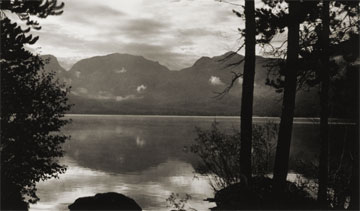
During the summer of 1960, Jeff E. Fuller and Don Drake formed Mountain Services Inc. to offer Grand Lake shore owners protection by patrolling the properties. In May of 1961, Don Drake promoted the idea of a fireboat and with donations, a 1960 18 foot Buehler Turbocraft Jet 56 was purchased and equipped to fight fires. Don tested the water jet and found that it would pump enough water to reach the fourth story of the five story-14 bedroom Oscar Malo home. Ironically, on September 10, 1961, that very home caught on fire. The home was completely engulfed by the time Don got the fireboat to the location but, with the help of Elmer Badger and Jerry Gruber, they concentrated on the 4-slip boathouse. The heat was so intense it melted the plastic trim on the fireboat but the boathouse was saved and still stands today.
|
| Health Care |
Health Care

In its earliest days of settlement, Middle Park area residents and travelers doctored themselves using whatever remedies they were able to concoct on the scene of accident, illness, or injury. The cure might have been a poultice of herbs, bread, oil, mustard, or something called Raleigh’s Ointment. It might have been a dip in the medicinal springs at Hot Sulphur, a dose of iodine, arnica or vinegar, castor oil, Epsom salts, or any number of other standbys. The first “doctors” known in the area were Dr. Hilery Harris (1874 or 1876) and Dr. David Bock (1876); both were “self-certified”. Dr. Harris had a predilection for the treatment of animals, while Dr. Bock treated the medical and dental needs of the people. By the mid-1880s, there were a number of doctors traveling through the area, working for various entities and setting up private practices. During the mining boom, there were a number of physicians and surgeons in Teller City, which was then a part of Grand County. Dr. Archie Sudan built a medical facility in Kremmling and Dr. Susan Anderson remodeled a barn in Fraser to accommodate her patients. Often it was the wife of the doctor, who might be a nurse, who attended the patients. Many of those in attendance were trained by the doctor in charge; some went on to attain certifications as Registered Nurses or other professionals. |
| Horses - Beyond Cow Punching |
Horses - Beyond Cow Punching
Article contributed by Jean Miller Horses were always valuable in the county, of course. Charlie Utter relied on horses in the mid-1860’s to support hunting parties. By the mid-1870’s, George Church used 30-40 horses to break trail through the snow to get his cattle over into Middle Park in early summer. Thomas Pharo had bought an early homestead on the Blue in 1877. He specialized in raising horses as well as cattle, averaging about 400 cattle and 450 horses. Pharo at times hired pioneer Dick McQueary to break horses for him. Ute Indians also loved horses and betting on horses. A man with an especially fast horse might bet all his own and his wife’s possessions -- and perhaps even his wife, on the outcome of a single race. Indeed, the Indians most prized possessions were their horses, which were extremely fast, particularly in short races. These racing characteristics of mixed-breed Indian ponies were later refined into today¹s fast-sprinting quarter horses. Riders rode bareback, kicking and yelling, using only a braided leather rope for control. The 200-300 yard long race course was placed on a good flat spot such as the bluff above present day Tabernash, on the L.J.Wade ranch on the Williams fork, north of Grand Lake, and perhaps near Hot Sulphur Springs. The horse as a beast of burden was necessary for war and raiding. But as an indicator of wealth, two horses could be traded for a wife or just one horse, if the wife wasn’t young and strong. A gift horse placated relatives in a messy divorce. Horses were traded for food, slaves, and necessary implements as well as clothing. Next to survival, breeding, racing, accumulating, and selling horses was the major occupation of the Utes. Chief Ouray was famous for his horses and for his horsemanship. In 1874, a group of San Juan miners decided to challenge the chief to a race, anticipating collecting large winnings. Ouray accepted, acted as his own jockey, and took all bets. He easily outdistanced all the miners’ horses and nearly bankrupted the miners. In the summer of 1878, the Utes were drinking and racing on the higher ground near Junction Ranch in today’s Tabernash. John Turner, the rancher, was uneasy, and he went for the sheriff in HSS. A posse arrived to remove the Indians or at least to convince them to move on. This action resulted in the killing of the Indian Tabernash, the subsequent killing of Abraham Elliott, and eventually contributed to the Meeker Massacre. In 1880, a certain Tom Ennis bought the Tracy Tyler property three miles east of Kremmling. At first Tom wasn’t interested in raising cattle. Through W.P. Farris of Georgetown, he became excited in trotting horses, though he never made any money off them. He, Farris, and Ad Kinney organized the Middle Park Trotting Association. Later he bought the Barney Day property near the mouth of the Troublesome in the 1920’s. All this eventually went to his son Ed, who, in 1956, sold to a Freddie Grimes. Others also considered horses as useful for purposes other than plowing, gathering cattle, and pulling wagons. Henry McElroy in 1908 established a livery stable, at one time keeping or boarding over 100 horses. In 1912 he, Johnny Atmore, Ed Case, and Harris Wade built a fine race track on his ranch near the present Fairgounds. Once completed, McElroy raised $2700.00 for the first Middle Park Fair. Freddie Grimes, now owner of the Ennis property, came from Loveland and was a bachelor when he established his first ranch on the Troublesome. Freddie worked hard at his ranching and owned a great deal of land during his years here. He had filed on his own homestead in 1937-38. Between 1940 through 1956, Grimes bought other homesteads, stretching from the remotest homestead of the Henricks family down almost to the Colorado River, to the west, dropping into the Muddy drainage and to the east, including the only two homesteads in Big Horn Park. At one point, Freddie sold his fine mountain hay to Bing Crosby for his race horses. Grimes was crazy over horses and horse racing. In fact, he owned Charmer, son of Man-of-War. A small man, Freddie was a ockey himself, and he hired others of the area to work for him sometimes. He wanted his neighbor, Alan Wheatley, son of Ken, to become a jockey, because Alan was quite small. Though interested, Alan finally chose ranching. Through Grimes, Lyle, son of Joe Shearer on the Troublesome, got so excited over horse racing that he rode for some years for a Roy Barnes in Denver. Lyle’s sister Lenore also worked at being a jockey for a while. Tillie Heeney Gingery was another local young person who rode some of Freddie’s horses. She had been raised on the Blue River, she was small, and she loved to ride. When Fred needed a rider to race in the Middle Park Fair, Tillie got the job; it was a lot of fun. She believes she may have been the only girl jockey in Colorado at that time. The first year she raced, her horse won against five or six other entries; but the second year a boy, racing against her, hit her mount across the nose with his quirt. She came in second. Afterward, she thinks Fred Grimes and her dad gave that boy a little “instruction” on track manners. For a while, in the 1950’s, Grand County had pari-mutuel betting , both during the Fair time and at separate times. There was quite a bit of money involved, so George Mitchell and Ted McMahan of Parshall were appointed to guard it, guns on their hips. However, the “high-rollers” decided there wasn’t enough money, so that kind of racing disappeared. Freddie’s drinking occasionally landed him in trouble. Once he had bought a new van for hauling horses. He stopped by the La Casa Café in Kremmling fora drink and later decided to “go to Grand Junction.” He proceeded to drive the vehicle down the railroad tracks, got stuck, bailed out, and never looked back as the train wiped out his new truck! By 1959 Grimes was selling property and by 1965, Gene and Lucille Wall bought most of his acreage. The remainder went to Ted and Florence Ritschard. Fred eventually went to Arkansas where he raced quarter horses and this period of raising race horses in Grand County came to an end.
|
| Hot Sulphur Springs Library |
Hot Sulphur Springs Library

The Hot Sulphur Springs Library started on the second floor of the two story white frame courthouse that preceded the current courthouse. In 1942 the library was moved to the old log courthouse that was directly behind the frame courthouse. The books were moved via a rope pulley-like system from the second floor to the log house. The library remained in the log courthouse until the mid 1970s when it moved into a 19 ft. 9 in. X 8 ft. 6 in. room in the current courthouse. This tiny room had a double-sided bookshelf in the middle, a bookshelf along one wall, a desk and a chair, and a card catalog on top of a small table. There was only a narrow pathway around the center shelving. There was no room to hold story hour for the 10-15 children who came, so story hour was held in the community room upstairs or the county or district courtrooms, the commissioners' room, or once on the stairs in the stairwell between the first and second floors. Much of the year the hallway by the Treasurer's and Assessor's offices was filled with hats, mittens, coats, boots and the noise and chaos of the children enjoying story hour. Since the jail was also located in the courthouse, the library was used by prisoners. Those who were "trustees" were allowed to visit the library in their neon orange jail suits. One prisoner was permitted to visit the library to paint a delightful mural of a dragon on one wall and a dog on the window in the door. One day a prisoner asked if he could order some Kurt Vonnegut books. The Librarian jumped up so excited that the tiny library had some Vonnegut books, she kneeled and pulled out a Vonnegut book titled Jailbird!!! In 1983 the new jail was built and the Library moved to the old jail area on the second floor. It was a much larger space and had a restroom. In the late spring of 1990 the Library moved to its present location in the newly-renovated former bunkhouse of the U.S. Forest Service summer personnel. This larger facility brought many windows and space for story hour, and a wonderful yard in back for story hour and summer reading program activities. |
- ‹ previous
- 3 of 7
- next ›








